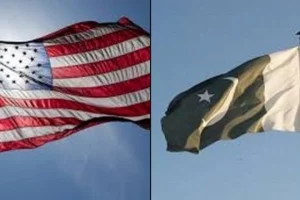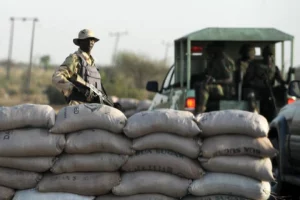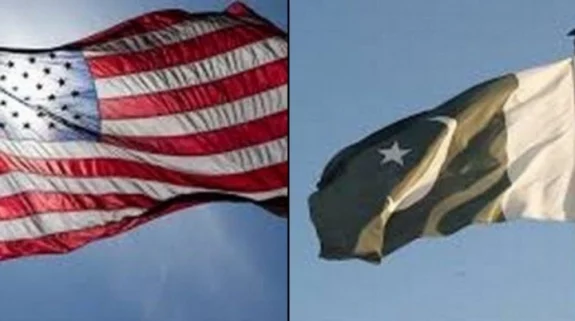The United States Air Force Global Strike Command announced yesterday the setting up of its first overseas mobile operations center for B-2 stealth bomber missions at its Naval Support Facility in Diego Garcia.
Established by the 393rd Expeditionary Bomb Squadron, Whiteman Air Force Base, Missouri, it fulfills the B-2 Spirit Stealth Bomber's promise of 'anytime-anywhere' and a fully functioning mission planning and monitoring facility on any airfield the B-2 can operate from.
The development will obviously set alarm bells ringing in Beijing which was already rattled by the deployment of three B-2 Spirit Stealth Bombers from the 509th Bomb Wing at Whiteman Air Force Base, Missouri to the strategically important base in Diego Garcia across the Pacific, last month.
Earlier in July, aircraft carrier USS Ronald Reagan (CVN 76) pulling out of its forward-deployed homeport of Yokosuka, Japan to hold drills in the region alongside USS Nimitz (CVN-68) had pushed the Chinese – who were preparing for naval drills in South China Sea, close to Taiwan – to go into the highest alert level.
"This is the future of bomber mission planning," said US Air Force Lt. Col. Christopher Conant, Bomber Task Force (BTF) commander. "Our objective out here is to create an ability to move a B-2 unit to any location in the world and generate combat sorties, as the Air Force Global Strike 2020 Strategic Plan outlines."
According to the US Air Force Global Strike 2020 Strategic Plan, in order to overcome the challenges the adversaries present, the commanders must embrace new considerations by reorienting, reinventing, and reimagining the future of operations in order to expand operational capacity and capabilities.
Currently, the 393rd EBS is testing the mobile facility from Diego Garcia. Once implemented across Air Force Global Strike Command, mobile operations centers like these can allow commanders across the world to employ bomber forces with more flexibility than in previous operations.
As the Squadron continues to develop the operational functionality of the mobile operations center, its integration with the bomber task force missions has already enhanced Air Force Global Strike Command's flexibility to deliver lethal, ready, long-range strike options to the US Indo-Pacific's area of responsibility.
The 29-hour sortie and arrival of the nuclear-capable strategic bombers in the Indian Ocean mid August had delivered a strong, instant message to China that the global powers were prepared to thwart any nefarious designs of the Xi Jinping regime, currently engaged in fulfilling its expansionist dreams from Taiwan Strait to the Ladakh region.
The US has repeatedly said that moving the bombers and aircraft carriers demonstrated its continued commitment to allies and partners by showcasing their ability to deliver lethal, ready, long-range strike options to Geographic Combatant Commanders anytime, anywhere.
<img class="wp-image-11533 size-full" src="https://indianarrative.com/wp-content/uploads/2020/09/USS-Ronald-Reagan.jpg" alt="" width="838" height="427" /> An F/A-18E assigned to the “Dambusters” of Strike Fighter Squadron (VFA) 195 launches off the flight deck of America’s only forward-deployed aircraft carrier USS Ronald Reagan (CVN 76) while conducting operations in the South China Sea. Ronald Reagan, the flagship of Carrier Strike Group 5, provides a combat-ready force that protects and defends the United States, as well the collective maritime interests of its allies and partners in the Indo-Pacific region. (U.S. Navy photo by Mass Communication Specialist 2nd Class Codie L. Soule)"We are excited to return to this important location. [Diego Garcia] puts the "INDO" in INDOPACOM. This Bomber Task Force is our National Defense Strategy in action. We are sharpening our lethality while strengthening relationships with key allies, partners, and our sister-service teammates. Despite a global pandemic, the Airmen of Whiteman Air Force Base and Air Force Global Strike Command stand ready to support INDOPACOM and the Department of Defense in achieving our Nation's strategic objectives," said Lt. Col. Christopher Conant, Commander of the Bomber Task Force (BTF).
It was not for the first time that the US had expressed clear support for its Indian Ocean allies and key partners – especially India.
"For US Pacific Command, it is our primary combatant command, it's standing watch and intimately engaged with over half of the earth's surface and its diverse populations, from Hollywood to Bollywood, from polar bears to penguins," the US Secretary of Defense James Mattis had said on May 30, 2018 as the US Pacific Command (PACOM) was renamed to US Indo-Pacific Command (INDOPACOM).
In the past too, the tiny island of Diego Garcia, located 3,000 miles west of Guam, has served as a staging area for the US personnel, aircraft and equipment during Central Command's Operation Iraqi Freedom and Enduring Freedom. The US military's Indo-Pacific Command ensures that the men and women, who are permanently stationed on Diego Garcia, are ready when called upon.
"Being a geographically separated unit, isolated and far away from all other Pacific Air Force units, makes operating it challenging. Fortunately, we have some of the best Airmen and highly skilled contractors manning our shops. Most of our equipment is war reserve and in storage when we are not supporting Pacific, Central or Global Strike Command operations. But when it is needed, the equipment is fully operational and ready for deployment. Being pre-positioned means we don't have to start from square one if Diego is ever needed to support wartime efforts in this fast-paced region," Senior Master Sgt. McAdams, Det. 1 superintendent, mentioned last year.
The B-2s low-observable, or 'stealth' characteristics give it the ability to penetrate an enemy's most sophisticated defenses and put at risk their most valuable targets. It is one of the several big machines US President Donald Trump has moved closer to China in order to keep its authoritarian regime in check.
On July 21, a pair of B-1B Lancers launched from Andersen AFB to conduct a long-range strategic Bomber Task Force (BTF) mission in the South China Sea. During the flight, the 37th Expeditionary Bomb Squadron (EBS) conducted a maritime integration operation with the USS Ronald Reagan carrier strike group in the Philippine Sea.
The B-1 serves as the backbone of America's long-range bomber force. The bomber has the ability to rapidly deliver massive quantities of precision and non-precision weapons against any adversary, anywhere in the world, at any time.
With China not relenting and still playing dirty war games in the Himalayas and the sea, it won't be very surprising to see the US military and mobile operation teams – and those of its allies – getting involved in some real time action very soon..




















